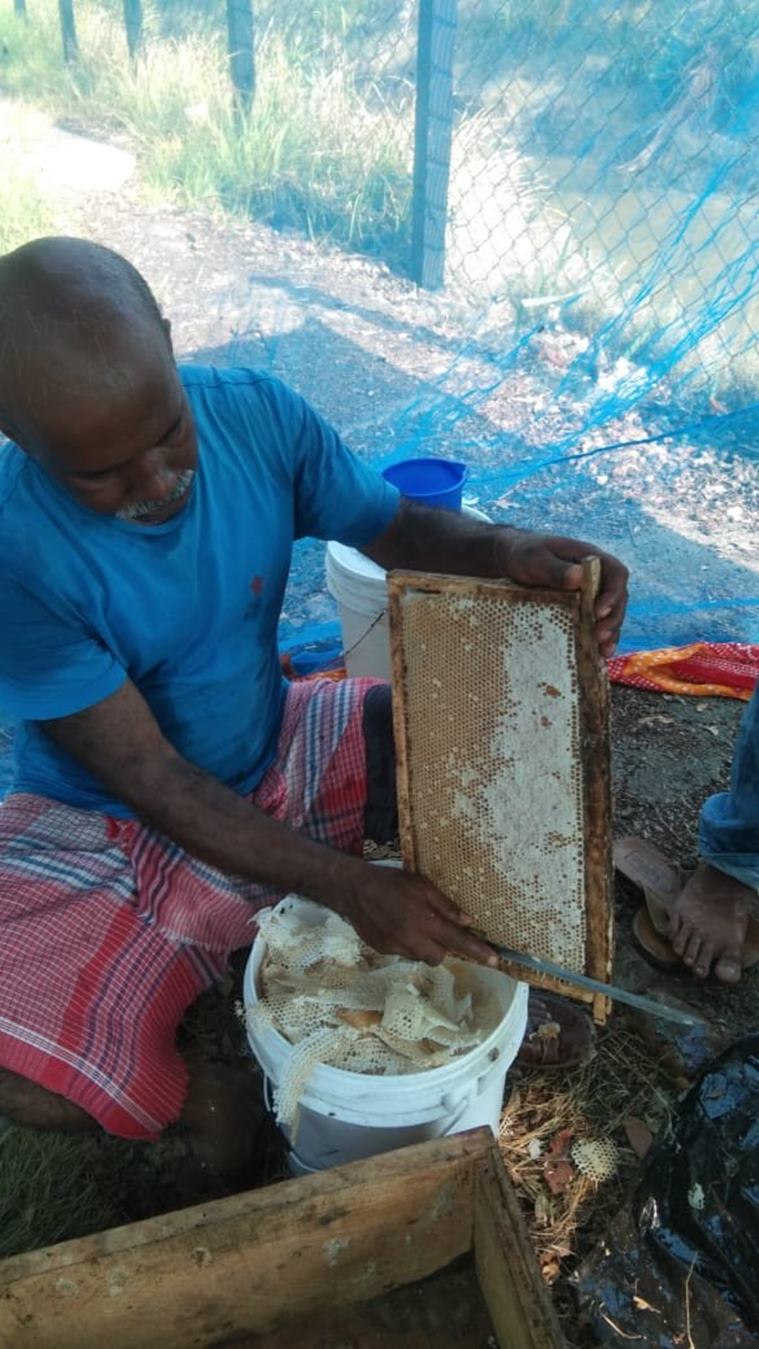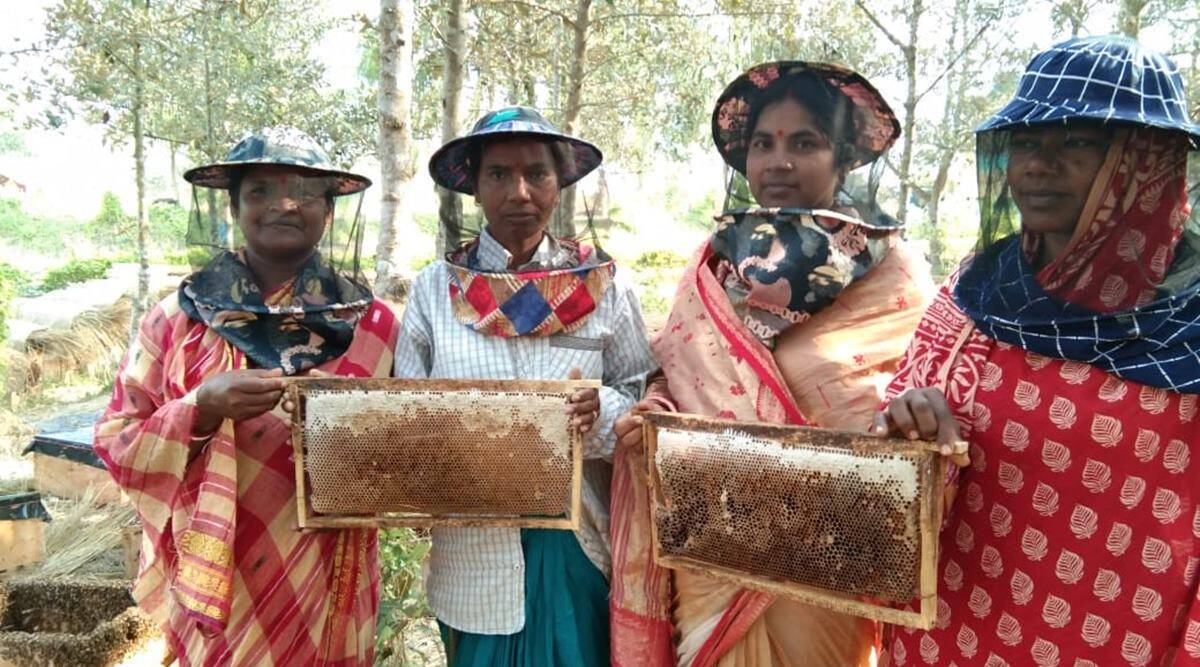| Kolkata |
Updated: December 5, 2020 3:54:17 pm

Women in the Sundarbans who belong to Mouli families are also involved with the three cooperatives and help produce Bonphool honey inside the forest department camps. (Photo credit: Debashish Mondal)
Traditional honey-gatherers in West Bengal who had been struggling to sell organic honey harvested from deep inside the mangrove forests of the Sundarbans have been provided an unexpected boost in sales after a recent investigation led by the Centre for Science & Environment, a New Delhi-based non-profit, found that honey sold by major brands in India was laced with modified sugar syrup.
While brands like Dabur and Patanjali rejected the investigation’s findings, defending the quality of their processed honey, Indian Forest Service officials took to social media to draw attention to unadulterated organic honey from the Sundarbans as a healthier alternative.
Three cooperatives set up last January by the West Bengal Forest Department, the state’s rural development department and the gram panchayat, had launched an initiative to help honey-gatherers in the Sundarbans produce and sell organic honey in a sustainable way. Although a year old, the programme is still in its infancy and doesn’t even have a formal name.
The response on social media and the subsequent demand for this unique honey sourced from the mangrove forests of West Bengal, took the honey-gatherers by surprise and for the past 48 hours, the rural cooperatives in charge of producing and packaging this honey, haven’t stopped working. For these honey-gatherers, hit hard by the nationwide lockdown in March followed by the devastation of Cyclone Amphan two months later, the endorsement has come as a lifeline.
For the Moulis, the honey-gatherers in the Sundarbans, honey collection is a source of income between March and May every year, when fishing is prohibited. “Amphan damaged everything. The (honey-collection) boxes were destroyed, bees were killed and the soil was ruined,” says Debashish Mondal, 28, whose family have been honey-gatherers for generations. “The cyclone ruined the roads so the honey that had been collected couldn’t be transported. Then the lockdown started and we couldn’t sell the produce.”
 “Moulis, traditional honey-gatherers in the Sundarbans holding up a brood nest full of bees, inside the forest department camp used to safely harvest Bonphool honey. (Photo credit: Debashish Mondal)
“Moulis, traditional honey-gatherers in the Sundarbans holding up a brood nest full of bees, inside the forest department camp used to safely harvest Bonphool honey. (Photo credit: Debashish Mondal)
Marketed as Bonphool honey — ‘bon’ means forest and ‘phool’ flower — the initiative was a brainchild of Santhosha Gubbi R who was serving as Divisional Forest Officer in the Sundarbans between 2018-2020, and Dr. M.V. Rao, Additional Chief Secretary, Panchayats and the Rural Development Department in the Government of West Bengal.
The initiative, explains Gubbi, was an attempt to reduce man-animal conflict in the Sundarbans by providing Moulis space to produce honey in a controlled area, and thus access to a steady income. “Many in the Sundarbans don’t have land, so they are completely dependent on fishing and honey-collection,” explains Gubbi, now associated with the West Bengal Forest Development Corporation.
Eking out a living for these Moulis is challenging in the harsh, unforgiving mudflats of the Sundarbans, but they say they have little choice. If they don’t enter the forests, they won’t be able to feed their families. Conflict with wildlife is inevitable, but due to the lack of alternatives, the Moulis knowingly put their lives at risk everyday. “On an average, in one season, five people lose their lives, and these are just the numbers we know. So many deaths go unreported,” says Gubbi.
Now, instead of going into the forests, the Moulis collect and produce honey inside designated forest camp areas, where the likelihood of man-wildlife conflict is significantly lower. For a long time, honey-collectors and their problems were invisible, but that changed last year when a group of them took their problems to Rao with a request for assistance.
 “A Mouli harvests Bonphool honey inside the forest department camp in the Sundarbans. (Photo credit: Debashish Mondal)
“A Mouli harvests Bonphool honey inside the forest department camp in the Sundarbans. (Photo credit: Debashish Mondal)
Rao suggested forming cooperatives to address the Moulis’ challenges on the ground-level. “The cooperatives were set up in 10 days and I requested the Bengal State Co-op Bank to sanction a loan for honey processing although it was a new initiative,” he says.
Within days, the three cooperatives, Kultali Sundarban Banarakshak Banmukhi Samabay Samity Ltd., the Nolgora Sundarban Banarakshak Bahumukhi Samabay Samity Ltd. and the Jharkhali Sundarban Banarakshak Bahumukhi Samabay Samity Ltd., were up and running, providing a steady source of income for 72 families across three villages in Sunderbans.
 Honey-gatherers in protective gear inspect brood boxes filled with hives kept inside forest department camps in the Sundarbans. Photo credit: Debashish Mondal.
Honey-gatherers in protective gear inspect brood boxes filled with hives kept inside forest department camps in the Sundarbans. Photo credit: Debashish Mondal.
Pralay Samanta, 30, a resident of Bhuvaneshwari village, oversees the manufacturing of Bonphool honey, and works as a social worker in the Sundarbans. Although he doesn’t go foraging, he knows the business and its dangers because his father and grandfather both worked as Moulis their entire lives.
The initiative to produce Bonphool honey is important for the people in Samnata’s village because tales of injuries and deaths are common. “Every year people go to collect honey or catch crabs in the small creeks deep inside the forests. Some take a permit from the Forest Department and some enter illegally. Mangrove forests are not easy to navigate, and they encounter tigers and crocodiles. But they still go in these circumstances,” says Samanta.
 Organic mangrove honey produced, packaged and distributed by traditional honey-gatherers in the Sundarbans, West Bengal, under the brand name ‘Bonphool’. Photo credit: Santhosha Gubbi R
Organic mangrove honey produced, packaged and distributed by traditional honey-gatherers in the Sundarbans, West Bengal, under the brand name ‘Bonphool’. Photo credit: Santhosha Gubbi R
The changing tides of the brackish water of the Sundarbans also expose the spindly aerial roots of the mangroves, making it yet another obstacle to watch out for to prevent injuries. “When the tide is low, people go in groups of six to seven in a boat, hunting for bee-hives in the forests, with two to three people watching out for tigers and crocodiles.”
Sometimes, Samanta says, accessing the beehives requires stepping out of the boats and wading through the muddy waters, waist-deep, their bodies caked with mud. “On any given day, they can sit for hours and get little to no honey.” The harvesting of honey is not a straightforward process; it requires immense skill because the Moulis need to remove the honeycomb without destroying the colony to ensure regeneration. For protection, they only have a thin cotton gamcha wrapped around their faces.
This initiative to produce Bonphool honey reduces the risk because the honey collection is done in a controlled environment, wearing protective gear, without compromising on the quality, explains Samanta. “The honey collection boxes are placed approximately 15 to 20 kilometers away from settlement areas, so like in the forests, there is no contamination,” says Mondal.
Unlike processed honey, Bonphool honey doesn’t have a uniform colour, because some 28 to 30 species of mangroves grow in the Sundarbans, producing various shades of honey, from golden to red to dark brown. “Mangrove honey is extremely sweet and watery in consistency. We are accustomed to thick honey, so it takes a while to get used to,” says Gubbi. It is also one of a kind, produced nowhere else in the world. “Honey is sweet, but the sweetness of mangrove honey leaves an aftertaste,” Mondal says.
According to Gubbi, in addition to making the process safer for the honey-gatherers and reducing distress for wildlife, the initiative has also helped honey-collectors get better rates for their produce. “One family would earn anything between Rs. 120 per kilo to Rs. 300 per kilo in the local markets. Now, they are selling it at Rs. 600 per kilo in a wider market. For each kilo they sell, the Moulis earn Rs. 300 to 350 per person,” he explains.
 After news spread of the authenticity of Bonphool honey earlier this week, the cooperatives in the Sundarbans haven’t stopped getting orders. Staff have been working round the clock to package and ship orders for the product. (Photo credit: Santhosha Gubbi R)
After news spread of the authenticity of Bonphool honey earlier this week, the cooperatives in the Sundarbans haven’t stopped getting orders. Staff have been working round the clock to package and ship orders for the product. (Photo credit: Santhosha Gubbi R)
Since the initiative started last year, the honey is being sold on Amazon, Flipkart, Biswa Bangla (under the West Bengal government), and through the cooperative’s own website (sundarbansjfmc.org). Till this week, the cooperative would struggle to sell five bottles of Bonphool honey, but that has changed after inquiries for the product spiked following the product’s endorsement on social media. “What we couldn’t sell in three months, we’ve done in 48 hours. In one day, we sold 1,300 units of honey alone,” Samanta says.
“It is easy to tell the Moulis not to go into the forest, but we have to provide a livelihood for them. Honey-collection was also something they had done throughout their lives, so this was the best fit,” Rao says.
© IE Online Media Services Pvt Ltd
This article is auto-generated by Algorithm Source: indianexpress.com



